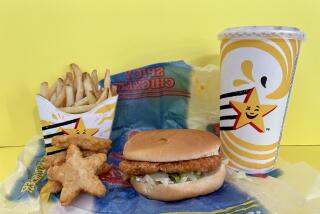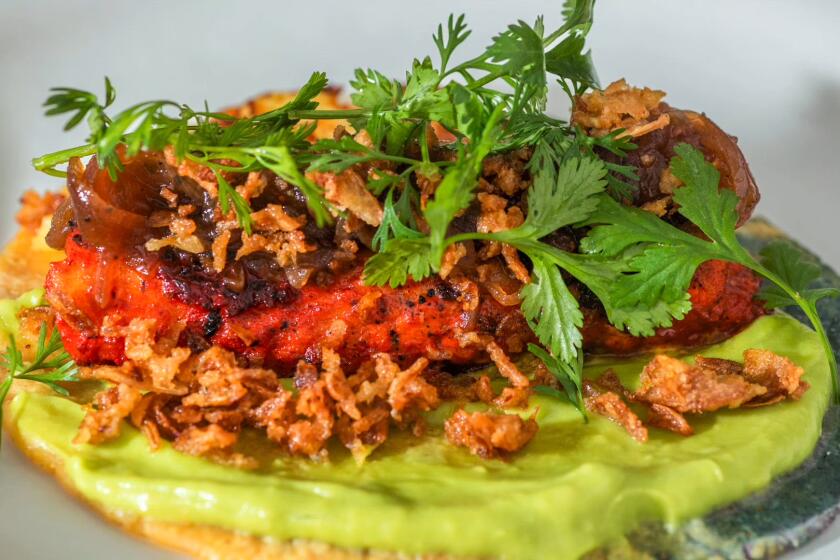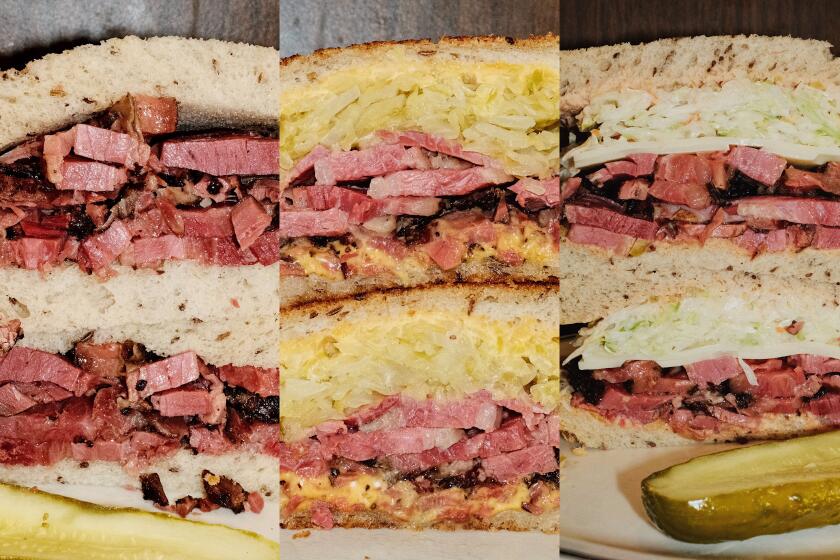Can two people eat on $67 a week?

I was reading a book about the joys of making your own bacon, preferably with mail-ordered pork belly, when my wife mentioned something about a food stamp challenge.
It sounded ominous.
We were considering buying a house and the economy seemed shaky, so it was a good time to tighten our belts, she said. We would live on $72 worth of food a week, she explained, about the same amount a family of two in California would get in food stamps.
Is that truly necessary? I asked. Sure, the cookbook suggests making bacon from pork that cost $88 for 9 pounds, but I was never actually going to do that. And we’re pretty thrifty, I argued. We splurge occasionally but we pack our own lunches most of the time, even grow some of our own vegetables.
But then she showed me our credit card statements and receipts, and I realized we weren’t actually that thrifty after all. We’d spent almost $700 the month before on food, including alcohol and going out.
Maybe it was time to cut back, I thought. And $72 sounded like a perfectly reasonable limit.
“Should we try it for a month?” I asked.
“How about two?” she countered.
We weren’t the first nor the most severe members of the Food Stamp Challenge -- in 2007, several members of Congress budgeted just $21 a person, the national average a food stamp recipient receives weekly. The focus of our challenge was different. We weren’t making a statement about hunger awareness or pretending we were poor; we wanted to change our lifestyle and our budget.
The federal food stamp formula is complicated and depends on income level and number of family members. More than 31 million Americans received food stamps in December, the latest data available, believed to be the highest rate ever.
We decided on some ground rules: We wouldn’t count the cost of food we already had in the pantry or freezer, and though we would accept gifts from family, we wouldn’t from friends, i.e. our parents could buy us dinner but our friends couldn’t pay for drinks.
It wasn’t as easy as we thought. For a couple who grow their own tomatoes and have olive oils for different occasions, it was hard to find a balance between eating affordably and healthfully, much less deliciously.
But, by the end, I had found that it was even possible to make your own bacon if you plan it right.
The first step was a trip to Costco. (I later discovered that Costco doesn’t accept food stamps, a reminder that although we were trying to live as if we were receiving government assistance, we were enjoying options that the truly impoverished don’t have.)
I typically try to shop as quickly as possible, but my wife and I spent five minutes just debating ham versus turkey for our sandwich meat. Both of us preferred turkey, but we decided on ham because it was cheaper and would be good for a couple of months, unlike turkey, which would last for only a week or two.
I briefly wondered how it was possible for lunch meat to last that long.
We had a lengthy discussion about lettuce. A six-pack of romaine heads cost less than $3, about as much as a small bag of mesclun at the farmers market.
We had wanted to be as organic and local as possible. I kept a copy of the book “The Omnivore’s Dilemma,” which espouses the virtues of eating locally, on my bedside table and spent a weekend expanding our small backyard garden with a pick and shovel to make more room for greens.
Price of produce
But our spinach had died, and the Costco romaine was really, really cheap. Then I recalled reading an article on Salon.com about how shipping 1,000 pieces of produce 1,000 miles could be as environmentally sound as 10 farmers driving 100 pieces of produce 100 miles. We put the romaine in the cart.
Our Costco grocery bill came to $67, so we decided to adopt that as our limit. We planned a menu for the first week and vowed to stick to it: oatmeal or eggs for breakfast, ham pita sandwiches and salad for lunch, ginger-lime chicken thighs for dinner.
It didn’t sound so bad.
However, I figured out the secret of the ham’s preservative powers the next day when I bit into my sandwich: salt. A lot of it.
It could’ve been worse, I told myself. A cousin who tried the challenge at the same time but stuck to organic fare was stretched so thin that she nearly burst into tears when she dropped a slice of pizza that was to have been her lunch.
Another cousin, the center on the family basketball team, mistakenly thought that each person got $72 weekly. Then he argued that even though he is single, because he eats more than me and my 5-foot-tall wife put together, he should be entitled to $144. When told he was essentially quadrupling his allowance, he promptly dropped out of the challenge.
One of the first questions my brother asked was whether I was getting enough to eat. I laughed, but by 3 p.m. my stomach was rumbling.
Pantry raid
When I got home, I made a pot of black beans from some dried legumes in our pantry and some brown rice. After chopping onion and garlic for the dish, I tossed the tops into a gallon freezer bag, figuring I’d save them for stock instead of composting them.
We also began shopping more at ethnic markets and found other places to cut corners. Instead of getting butchered duck legs at 99 Ranch, I decided to buy the whole bird and deal with it at home. While my wife hid, I sawed off the legs and breasts, which we used for four meals.
I briefly considered saving the carcass to make stock, but decided that I didn’t want to see what would happen to the webbed feet after a few hours on a low boil. I put it in the garbage.
While hauling away the duck remains, it occurred to me that that was the first time I’d taken out the garbage in at least three days. I normally took the trash out every other day. Since we were sticking to a plan and using everything in our refrigerator instead of forgetting about, say, half a head of broccoli that eventually would go bad, we were more efficient.
That thriftiness also led to some unexpected combinations. My wife bought a large bag of shiitake mushrooms at 99 Ranch and we put them in a stir-fry on a Monday, which was fine. By Friday, I was mixing them into omelets, the fluffiness of the eggs intercut with the chewiness of the mushrooms.
We’d stopped going out to eat almost entirely, turning down invitations to dinner and brunch. My parents took us out to dinner one night, and then gave us a paper bag full of frozen bison meat leftover from one of their own food experiments. (“It’s low-fat!” my mom said).
Though we were grateful for the gift, we were also a little leery. My mom had made it once, and we’d all agreed that it was too dry and tasted bloody rare even when well done.
Once my wife and I thawed the bison, which looked like a dark red pork loin, we debated how to make it appetizing. The first option, to sear it and make a red wine reduction sauce, preferably with a lot of butter, was too expensive once we figured in the cost of the sauce. Instead, we put it in chili. After a few hours of simmering, it tasted just like beef.
The meat was actually a welcome break in our diet, which was heavy on starches and basic fruits and vegetables. After eating what seemed to be my 100th apple, I began to regret that we hadn’t done this during the summer when there would have been more variety.
But even though I was getting my share of protein, I still longingly flipped through cookbooks and began to crave a steak, which would’ve blown the budget.
Salvation came in the form of a co-worker who was reporting on Philippe the Original’s 100th anniversary celebration, which featured 10-cent sandwiches. She asked me if I wanted her to bring me a French dip, and I could barely contain my enthusiasm.
I calculated how many sandwiches I could get for $67 and how many would fit in my freezer, but decided they wouldn’t keep very well. Nevertheless, I inhaled the one French dip I did get.
We were ruthlessly efficient by the end of the seventh week, when we spent only $45 on food. When we got our credit card bill for October, we discovered we’d spent only $250 on food that month, about $18 less than our budget and almost a third less than what we’d spent before starting the challenge.
But by then, I was looking forward to ending our experiment and returning to our regular life.
That wasn’t as easy as we thought it would be.
Decisions, decisions
When we decided to stop by Noah’s Bagels for lunch, a semi-regular treat in the past, we were aghast at the prices. Was a bagel sandwich worth $7.29? Wouldn’t it be cheaper to just buy a dozen bagels and then get sandwich makings elsewhere?
“Can I help you?” a confused-looking Noah’s employee asked. “Give us a minute,” we replied. The people behind us coughed politely. “Go ahead,” we told them before continuing our debate.
Finally, we decided to order a roast beef for me and a bagel and lox for her. A grand total of $14.58, almost a quarter of our weekly budget. I felt guilty, wasteful, and I could tell my wife felt the same. I guess we won’t be returning to our regular eating habits any time soon, I thought, pleased and yet also slightly dismayed that I’d never get to make my mail-ordered bacon.
But on my next trip to the Chinese market, I bought 10 pounds of pork belly for $14, and rubbed it with a mixture of salts and brown sugar and let it cure in the refrigerator for a week.
I smoked it on a Saturday and removed the skin once it had cooled. We sliced and fried the bacon and made BLTs with some friends we hadn’t seen for awhile. The bacon was delicious, not too salty, crisp on the outside and chewy on the inside.
Then I used the skin to flavor another pot of beans.
More to Read
Eat your way across L.A.
Get our weekly Tasting Notes newsletter for reviews, news and more.
You may occasionally receive promotional content from the Los Angeles Times.










